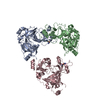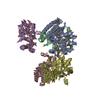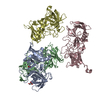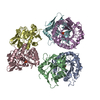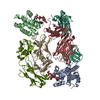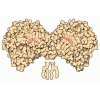[English] 日本語
 Yorodumi
Yorodumi- EMDB-30230: Cryo-EM Structure for the Insulin Binding Region in the Ectodomai... -
+ Open data
Open data
- Basic information
Basic information
| Entry | Database: EMDB / ID: EMD-30230 | |||||||||
|---|---|---|---|---|---|---|---|---|---|---|
| Title | Cryo-EM Structure for the Insulin Binding Region in the Ectodomain of the Full-length Human Insulin Receptor in Complex with 1 Insulin | |||||||||
 Map data Map data | ||||||||||
 Sample Sample |
| |||||||||
 Keywords Keywords | Human Insulin Receptor / Full-length / Ectodomain / Insulin / Conformation. / SIGNALING PROTEIN | |||||||||
| Function / homology |  Function and homology information Function and homology informationcellular response to oxygen-containing compound / regulation of female gonad development / positive regulation of meiotic cell cycle / insulin-like growth factor II binding / positive regulation of developmental growth / male sex determination / insulin receptor complex / insulin-like growth factor I binding / positive regulation of protein-containing complex disassembly / insulin receptor activity ...cellular response to oxygen-containing compound / regulation of female gonad development / positive regulation of meiotic cell cycle / insulin-like growth factor II binding / positive regulation of developmental growth / male sex determination / insulin receptor complex / insulin-like growth factor I binding / positive regulation of protein-containing complex disassembly / insulin receptor activity / exocrine pancreas development / dendritic spine maintenance / cargo receptor activity / insulin binding / adrenal gland development / neuronal cell body membrane / negative regulation of glycogen catabolic process / PTB domain binding / positive regulation of nitric oxide mediated signal transduction / negative regulation of feeding behavior / negative regulation of fatty acid metabolic process / Signaling by Insulin receptor / IRS activation / Insulin processing / regulation of protein secretion / positive regulation of peptide hormone secretion / positive regulation of respiratory burst / amyloid-beta clearance / negative regulation of acute inflammatory response / Regulation of gene expression in beta cells / alpha-beta T cell activation / positive regulation of receptor internalization / regulation of embryonic development / insulin receptor substrate binding / protein kinase activator activity / positive regulation of dendritic spine maintenance / Synthesis, secretion, and deacylation of Ghrelin / negative regulation of respiratory burst involved in inflammatory response / epidermis development / negative regulation of protein secretion / activation of protein kinase B activity / positive regulation of insulin receptor signaling pathway / negative regulation of gluconeogenesis / positive regulation of glycogen biosynthetic process / fatty acid homeostasis / Signal attenuation / FOXO-mediated transcription of oxidative stress, metabolic and neuronal genes / negative regulation of lipid catabolic process / heart morphogenesis / positive regulation of lipid biosynthetic process / regulation of protein localization to plasma membrane / transport across blood-brain barrier / negative regulation of oxidative stress-induced intrinsic apoptotic signaling pathway / phosphatidylinositol 3-kinase binding / nitric oxide-cGMP-mediated signaling / transport vesicle / COPI-mediated anterograde transport / positive regulation of nitric-oxide synthase activity / Insulin receptor recycling / negative regulation of reactive oxygen species biosynthetic process / insulin-like growth factor receptor binding / positive regulation of brown fat cell differentiation / NPAS4 regulates expression of target genes / dendrite membrane / endoplasmic reticulum-Golgi intermediate compartment membrane / neuron projection maintenance / positive regulation of mitotic nuclear division / Insulin receptor signalling cascade / receptor-mediated endocytosis / positive regulation of glycolytic process / positive regulation of cytokine production / positive regulation of long-term synaptic potentiation / endosome lumen / acute-phase response / positive regulation of protein secretion / positive regulation of D-glucose import / learning / insulin receptor binding / positive regulation of cell differentiation / Regulation of insulin secretion / wound healing / receptor protein-tyrosine kinase / positive regulation of neuron projection development / hormone activity / negative regulation of protein catabolic process / regulation of synaptic plasticity / caveola / cellular response to growth factor stimulus / receptor internalization / Golgi lumen / positive regulation of protein localization to nucleus / memory / cognition / vasodilation / male gonad development / cellular response to insulin stimulus / glucose metabolic process / positive regulation of nitric oxide biosynthetic process / insulin receptor signaling pathway / late endosome Similarity search - Function | |||||||||
| Biological species |  Homo sapiens (human) Homo sapiens (human) | |||||||||
| Method | single particle reconstruction / cryo EM / Resolution: 3.8 Å | |||||||||
 Authors Authors | Yu D / Zhang X / Sun J / Li X / Wu Z / Han X / Fan C / Ma Y / Ouyang Q / Wang T | |||||||||
 Citation Citation |  Journal: To Be Published Journal: To Be PublishedTitle: Insulin Binding Induced the Ectodomain Conformational Dynamics in the Full-length Human Insulin Receptor Authors: Yu D / Zhang X / Sun J / Li X / Wu Z / Han X / Fan C / Ma Y / Ouyang Q / Wang T | |||||||||
| History |
|
- Structure visualization
Structure visualization
| Movie |
 Movie viewer Movie viewer |
|---|---|
| Structure viewer | EM map:  SurfView SurfView Molmil Molmil Jmol/JSmol Jmol/JSmol |
- Downloads & links
Downloads & links
-EMDB archive
| Map data |  emd_30230.map.gz emd_30230.map.gz | 1.4 MB |  EMDB map data format EMDB map data format | |
|---|---|---|---|---|
| Header (meta data) |  emd-30230-v30.xml emd-30230-v30.xml emd-30230.xml emd-30230.xml | 24.2 KB 24.2 KB | Display Display |  EMDB header EMDB header |
| FSC (resolution estimation) |  emd_30230_fsc.xml emd_30230_fsc.xml | 5.8 KB | Display |  FSC data file FSC data file |
| Images |  emd_30230.png emd_30230.png | 148.3 KB | ||
| Masks |  emd_30230_msk_1.map emd_30230_msk_1.map | 15.6 MB |  Mask map Mask map | |
| Filedesc metadata |  emd-30230.cif.gz emd-30230.cif.gz | 7.2 KB | ||
| Others |  emd_30230_half_map_1.map.gz emd_30230_half_map_1.map.gz emd_30230_half_map_2.map.gz emd_30230_half_map_2.map.gz | 11.8 MB 11.8 MB | ||
| Archive directory |  http://ftp.pdbj.org/pub/emdb/structures/EMD-30230 http://ftp.pdbj.org/pub/emdb/structures/EMD-30230 ftp://ftp.pdbj.org/pub/emdb/structures/EMD-30230 ftp://ftp.pdbj.org/pub/emdb/structures/EMD-30230 | HTTPS FTP |
-Validation report
| Summary document |  emd_30230_validation.pdf.gz emd_30230_validation.pdf.gz | 596.7 KB | Display |  EMDB validaton report EMDB validaton report |
|---|---|---|---|---|
| Full document |  emd_30230_full_validation.pdf.gz emd_30230_full_validation.pdf.gz | 596.3 KB | Display | |
| Data in XML |  emd_30230_validation.xml.gz emd_30230_validation.xml.gz | 10.9 KB | Display | |
| Data in CIF |  emd_30230_validation.cif.gz emd_30230_validation.cif.gz | 15.1 KB | Display | |
| Arichive directory |  https://ftp.pdbj.org/pub/emdb/validation_reports/EMD-30230 https://ftp.pdbj.org/pub/emdb/validation_reports/EMD-30230 ftp://ftp.pdbj.org/pub/emdb/validation_reports/EMD-30230 ftp://ftp.pdbj.org/pub/emdb/validation_reports/EMD-30230 | HTTPS FTP |
-Related structure data
| Related structure data |  7bw8MC  7bw7C  7bwaC C: citing same article ( M: atomic model generated by this map |
|---|---|
| Similar structure data |
- Links
Links
| EMDB pages |  EMDB (EBI/PDBe) / EMDB (EBI/PDBe) /  EMDataResource EMDataResource |
|---|---|
| Related items in Molecule of the Month |
- Map
Map
| File |  Download / File: emd_30230.map.gz / Format: CCP4 / Size: 15.6 MB / Type: IMAGE STORED AS FLOATING POINT NUMBER (4 BYTES) Download / File: emd_30230.map.gz / Format: CCP4 / Size: 15.6 MB / Type: IMAGE STORED AS FLOATING POINT NUMBER (4 BYTES) | ||||||||||||||||||||||||||||||||||||||||||||||||||||||||||||||||||||
|---|---|---|---|---|---|---|---|---|---|---|---|---|---|---|---|---|---|---|---|---|---|---|---|---|---|---|---|---|---|---|---|---|---|---|---|---|---|---|---|---|---|---|---|---|---|---|---|---|---|---|---|---|---|---|---|---|---|---|---|---|---|---|---|---|---|---|---|---|---|
| Voxel size | X=Y=Z: 1.37 Å | ||||||||||||||||||||||||||||||||||||||||||||||||||||||||||||||||||||
| Density |
| ||||||||||||||||||||||||||||||||||||||||||||||||||||||||||||||||||||
| Symmetry | Space group: 1 | ||||||||||||||||||||||||||||||||||||||||||||||||||||||||||||||||||||
| Details | EMDB XML:
CCP4 map header:
| ||||||||||||||||||||||||||||||||||||||||||||||||||||||||||||||||||||
-Supplemental data
- Sample components
Sample components
-Entire : Human Insulin Receptor Complexed with 1 Insulin
| Entire | Name: Human Insulin Receptor Complexed with 1 Insulin |
|---|---|
| Components |
|
-Supramolecule #1: Human Insulin Receptor Complexed with 1 Insulin
| Supramolecule | Name: Human Insulin Receptor Complexed with 1 Insulin / type: complex / ID: 1 / Parent: 0 / Macromolecule list: all |
|---|---|
| Source (natural) | Organism:  Homo sapiens (human) Homo sapiens (human) |
| Molecular weight | Theoretical: 130 KDa |
-Supramolecule #2: Insulin receptor
| Supramolecule | Name: Insulin receptor / type: complex / ID: 2 / Parent: 1 / Macromolecule list: #1 |
|---|---|
| Source (natural) | Organism:  Homo sapiens (human) Homo sapiens (human) |
-Supramolecule #3: Insulin
| Supramolecule | Name: Insulin / type: complex / ID: 3 / Parent: 1 / Macromolecule list: #2 |
|---|
-Macromolecule #1: Insulin receptor
| Macromolecule | Name: Insulin receptor / type: protein_or_peptide / ID: 1 / Number of copies: 2 / Enantiomer: LEVO / EC number: receptor protein-tyrosine kinase |
|---|---|
| Source (natural) | Organism:  Homo sapiens (human) Homo sapiens (human) |
| Molecular weight | Theoretical: 154.114516 KDa |
| Recombinant expression | Organism:  Homo sapiens (human) Homo sapiens (human) |
| Sequence | String: HLYPGEVCPG MDIRNNLTRL HELENCSVIE GHLQILLMFK TRPEDFRDLS FPKLIMITDY LLLFRVYGLE SLKDLFPNLT VIRGSRLFF NYALVIFEMV HLKELGLYNL MNITRGSVRI EKNNELCYLA TIDWSRILDS VEDNYIVLNK DDNEECGDIC P GTAKGKTN ...String: HLYPGEVCPG MDIRNNLTRL HELENCSVIE GHLQILLMFK TRPEDFRDLS FPKLIMITDY LLLFRVYGLE SLKDLFPNLT VIRGSRLFF NYALVIFEMV HLKELGLYNL MNITRGSVRI EKNNELCYLA TIDWSRILDS VEDNYIVLNK DDNEECGDIC P GTAKGKTN CPATVINGQF VERCWTHSHC QKVCPTICKS HGCTAEGLCC HSECLGNCSQ PDDPTKCVAC RNFYLDGRCV ET CPPPYYH FQDWRCVNFS FCQDLHHKCK NSRRQGCHQY VIHNNKCIPE CPSGYTMNSS NLLCTPCLGP CPKVCHLLEG EKT IDSVTS AQELRGCTVI NGSLIINIRG GNNLAAELEA NLGLIEEISG YLKIRRSYAL VSLSFFRKLR LIRGETLEIG NYSF YALDN QNLRQLWDWS KHNLTITQGK LFFHYNPKLC LSEIHKMEEV SGTKGRQERN DIALKTNGDQ ASCENELLKF SYIRT SFDK ILLRWEPYWP PDFRDLLGFM LFYKEAPYQN VTEFDGQDAC GSNSWTVVDI DPPLRSNDPK SQNHPGWLMR GLKPWT QYA IFVKTLVTFS DERRTYGAKS DIIYVQTDAT NPSVPLDPIS VSNSSSQIIL KWKPPSDPNG NITHYLVFWE RQAEDSE LF ELDYCLKGLK LPSRTWSPPF ESEDSQKHNQ SEYEDSAGEC CSCPKTDSQI LKELEESSFR KTFEDYLHNV VFVPRKTS S GTGAEDPRPS RKRRSLGDVG NVTVAVPTVA AFPNTSSTSV PTSPEEHRPF EKVVNKESLV ISGLRHFTGY RIELQACNQ DTPEERCSVA AYVSARTMPE AKADDIVGPV THEIFENNVV HLMWQEPKEP NGLIVLYEVS YRRYGDEELH LCVSRKHFAL ERGCRLRGL SPGNYSVRIR ATSLAGNGSW TEPTYFYVTD YLDVPSNIAK IIIGPLIFVF LFSVVIGSIY LFLRKRQPDG P LGPLYASS NPEYLSASDV FPCSVYVPDE WEVSREKITL LRELGQGSFG MVYEGNARDI IKGEAETRVA VKTVNESASL RE RIEFLNE ASVMKGFTCH HVVRLLGVVS KGQPTLVVME LMAHGDLKSY LRSLRPEAEN NPGRPPPTLQ EMIQMAAEIA DGM AYLNAK KFVHRDLAAR NCMVAHDFTV KIGDFGMTRD IYETDYYRKG GKGLLPVRWM APESLKDGVF TTSSDMWSFG VVLW EITSL AEQPYQGLSN EQVLKFVMDG GYLDQPDNCP ERVTDLMRMC WQFNPKMRPT FLEIVNLLKD DLHPSFPEVS FFHSE ENKA PESEELEMEF EDMENVPLDR SSHCQREEAG GRDGGSSLGF KRSYEEHIPY THMNGGKKNG RILTLPRSNP S UniProtKB: Insulin receptor |
-Macromolecule #2: Insulin fusion
| Macromolecule | Name: Insulin fusion / type: protein_or_peptide / ID: 2 / Number of copies: 1 / Enantiomer: LEVO |
|---|---|
| Source (natural) | Organism:  Homo sapiens (human) Homo sapiens (human) |
| Molecular weight | Theoretical: 8.380529 KDa |
| Recombinant expression | Organism:  |
| Sequence | String: FVNQHLCGSH LVEALYLVCG ERGFFYTPKT RREAEDLQGS LQPLALEGSL QKRGIVEQCC TSICSLYQLE NYCN UniProtKB: Insulin, Insulin, Insulin |
-Experimental details
-Structure determination
| Method | cryo EM |
|---|---|
 Processing Processing | single particle reconstruction |
| Aggregation state | particle |
- Sample preparation
Sample preparation
| Concentration | 0.4 mg/mL | |||||||||||||||
|---|---|---|---|---|---|---|---|---|---|---|---|---|---|---|---|---|
| Buffer | pH: 7.4 Component:
| |||||||||||||||
| Grid | Model: C-flat-1.2/1.3 / Material: GOLD / Mesh: 300 / Support film - Material: CARBON / Support film - topology: HOLEY ARRAY / Support film - Film thickness: 20 / Pretreatment - Type: GLOW DISCHARGE / Pretreatment - Time: 60 sec. | |||||||||||||||
| Vitrification | Cryogen name: ETHANE / Chamber humidity: 100 % / Chamber temperature: 4 K / Instrument: FEI VITROBOT MARK III | |||||||||||||||
| Details | The sample was prepared using the gradient fixation method. |
- Electron microscopy
Electron microscopy
| Microscope | FEI TITAN KRIOS |
|---|---|
| Specialist optics | Energy filter - Name: GIF Bioquantum / Energy filter - Slit width: 20 eV |
| Image recording | Film or detector model: GATAN K2 QUANTUM (4k x 4k) / Detector mode: SUPER-RESOLUTION / Number grids imaged: 5 / Number real images: 17122 / Average exposure time: 10.0 sec. / Average electron dose: 50.0 e/Å2 Details: Images were collected in movie mode with 40 frames per 10 seconds. |
| Electron beam | Acceleration voltage: 300 kV / Electron source:  FIELD EMISSION GUN FIELD EMISSION GUN |
| Electron optics | C2 aperture diameter: 70.0 µm / Calibrated defocus max: 2.7 µm / Calibrated defocus min: 0.7000000000000001 µm / Calibrated magnification: 43796 / Illumination mode: FLOOD BEAM / Imaging mode: BRIGHT FIELD / Cs: 2.7 mm / Nominal defocus max: 2.7 µm / Nominal defocus min: 0.7000000000000001 µm / Nominal magnification: 105000 |
| Sample stage | Specimen holder model: FEI TITAN KRIOS AUTOGRID HOLDER / Cooling holder cryogen: NITROGEN |
| Experimental equipment |  Model: Titan Krios / Image courtesy: FEI Company |
+ Image processing
Image processing
-Atomic model buiding 1
| Initial model |
| ||||||||
|---|---|---|---|---|---|---|---|---|---|
| Refinement | Space: REAL / Protocol: FLEXIBLE FIT / Overall B value: 85 / Target criteria: Correlation coefficient | ||||||||
| Output model |  PDB-7bw8: |
 Movie
Movie Controller
Controller







